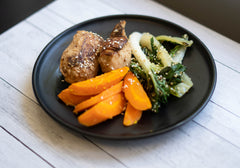Food Waste Hacks During COVID-19
The current COVID-19 situation is making it a little bit more difficult to find certain items and to visit the grocery store as much as we’d like. That’s why we think this is the best time to start thinking more about reducing our food waste through conscious consumption. There are lots of ways that you can start extending your food and produce and keep your waste as low as possible in the kitchen, such as using up your food scraps, paying a little more love to your ‘funny’ produce, and repurposing your leftovers.
Here are a few of our ideas and tips:
- DIY broth – save your veggie scraps and your odds and ends (like clean carrot tops, kale stalks, potato skins) to make a homemade broth. You can store all your scraps in a bag in the freezer and at the end of the week once it’s full, use it to make broth with some added seasonings and bay leaves. Having a batch of homemade stock on hand will make cooking easier, will help to create less waste by using the scraps you would have normally thrown out, plus you know what’s in it! This is a great way to use up your leftover produce and save money.
- DIY breadcrumbs – use your leftover stale bread to make breadcrumbs! Pulse together in a food processor and use them for toppings, as a binding ingredient or to crumb chicken or fish.
- Freeze your herbs! We all know that fresh herbs go bad very quickly. Remove the leaves from the stems and chop up. Keep them in a freezer bag for easy storage. Leftover coriander can be added to smoothies (it’s a great heavy metal and toxin detoxer).
- Freeze leftover amounts of tomato paste, curry pastes, sauces – avoid putting your jars of opened pastes back in the fridge to go bad, instead you can add them to ice cube trays and freeze. Once frozen, pop them out and into a freezer bag and label accordingly.
- Love your ‘funny’ produce! Bruised apples are amazing for making apple sauce or apple butter. Soft pears for making ice blocks or smoothies, and bruised bananas for making banana ‘ice cream’ or banana bread.
- Use up those tomatoes! Make your own salsa or pasta sauce like a puttanesca sauce with olives and capers.
- Greens, greens, greens! If you’re having lots of green vegetables go bad, you’re probably not eating them fast enough! Throw them in a blender, juice them, steam them, or make kale chips.

